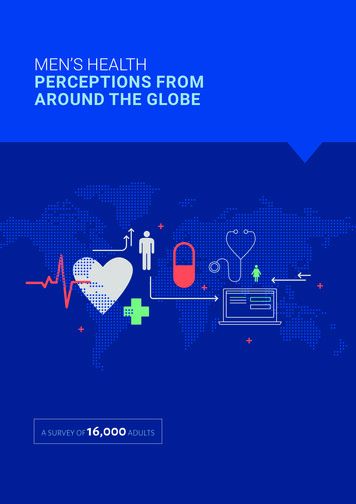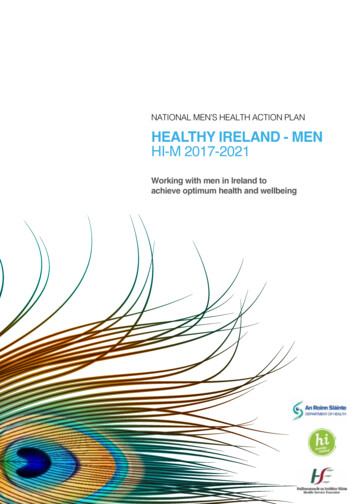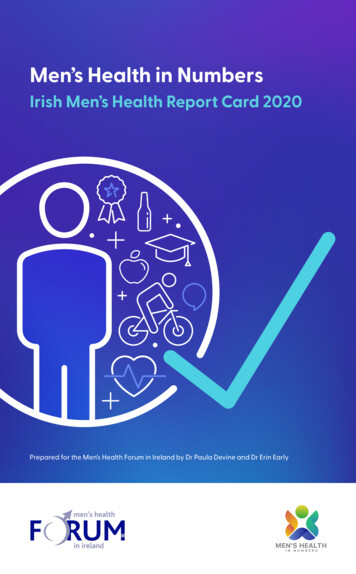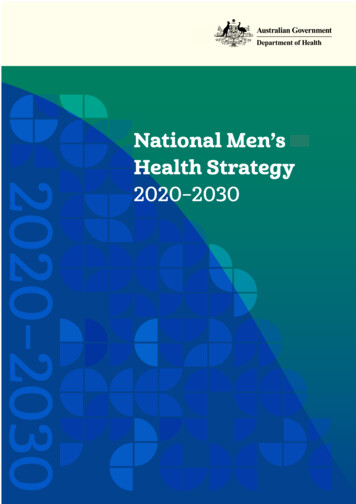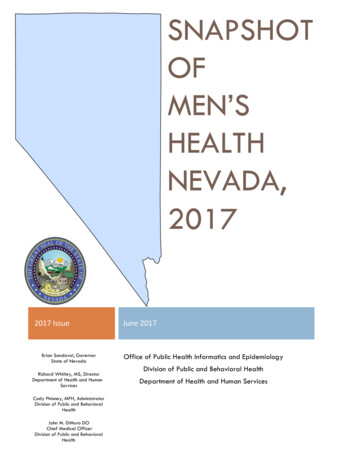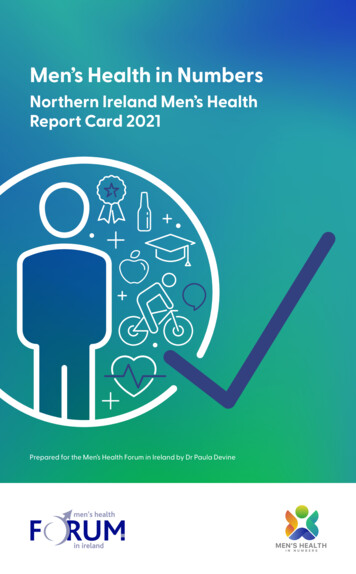
Transcription
MEN’S HEALTHaround the worldA review of policy and progressacross 11 countriesEdited by David Wilkins and Erick SavoyePublished by the European Men’s Health Forum (EMHF)Spring 2009
AcknowledgementsEMHF wishes to thank all the authors listed in this document for their contributions, time anddedication. I am confident their hard work will contribute to enhancing the public policy profileof men’s health in their country.Our special thanks to the Men’s Health Forum England & Wales (MHF) and to David Wilkins,MHF’s Policy officer, who had the laborious task of coordinating this project and without whomthis project would have never seen the light of day.Erick SavoyeDirector of EMHF
European Men’s Health Forum 2009All rights reserved. The European Men’s Health Forum welcomes requests for permission toreproduce or translate its publications, in part or in full.The designations employed and the presentation of the material in this publication do not imply the expression of any opinion whatsoever on the part of the European Men’s Health Forum.The mention of specific companies or of certain manufacturers’ products does not imply thatthey are endorsed or recommended by the European Men’s Health Forum in preference to others of a similar nature that are not mentioned.All reasonable precautions have been taken by the European Men’s Health Forum to verify the information contained in this publication. However, the published material is being distributed without warranty of any kind, either express or implied. The responsibility for the interpretation anduse of the material lies with the reader. In no event shall the European Men’s Health Forum be liable for damages arising from its use. The views expressed by authors, editors, or expert groups donot necessarily represent the decisions or the stated policy of the European Men’s Health Forum.european men’s health forumCopyright European Men’s Health Forum (EMHF) - Spring 2009ISBN: 978-1-906121-48-8The European Men’s Health Forum (EMHF)Rue de l’Industrie 11B-1000 BrusselsBelgiumRegistered in Belgium as international not-for-profit organisation A.I.S.B.L 15747/2002office@emhf.orgwww.emhf.org
ContentsIntroduction7Men’s health in Australia13Men’s health in Canada19Men’s health in Denmark25Men’s health in England & Wales29Men’s health in Ireland35Men’s health in Malaysia41Men’s health in New Zealand47Men’s health in Norway53Men’s health in Scotland59Men’s health in Switzerland65Men’s health in the USA69Men’s health in Europe: an overview75
IntroductionDavid WilkinsIs the health of men important?This may seem like a rather fundamental question to ask at the beginning of a review of policyand progress in male health across eleven countries. On one level, the answer is bound to be“yes”. Of course the health of every individual man everywhere in the world matters to him andto the people who care about him. The evidence about whether men’s health is important topoliticians and health planners however, is rather less convincing. Campaigners for better malehealth from three continents report in this paper that, despite enormous progress in publichealth and the sophistication of modern treament approaches, men consistently suffer moreserious illness than women and die at an earlier age.Does the very consistency of these patterns suggest though, that poorer health in men is inevitable. Is it a simple matter of biology?In fact, the biological arguments are much less important than they first appear. There isvery significant variation in male/female comparitive mortality rates between one countryand another. Female life expectancy in the Russian Federation is more than 13 years greaterthat male life expectancy; in the Netherlands the difference is only a little over four years.Biology alone cannot explain this. The scientific consensus tends to be that inherent differencesbetween men and women are at most only partly responsible for the discrepancies in morbidityand mortality rates1.Comparing male health with female health is crucial to our debate because it brings into focusthose factors that are different for men. But if we put male/female comparisons to one side fora moment, it can be seen that male life expectancy also varies considerably between differentgroups of men within as well as between countries. Indeed male life expectancy varies withineven very small geographical areas. In England for example, it is often pointed out that for eachstation east from central London on the city’s underground railway system, male life expectancyfalls by nearly a year; a man born in the affluent heart of the city, in Westminster, can expectalmost to reach the age of 79; a man born a few miles away in Canning Town in East London willnot live to see 73. Similar variations in mortality rates can be seen within cities and between regions throughout the world.7
We can easily see therefore that both the sex-comparative data and the data that comparesgroups of men suggest that non-biological factors are extremely important determinants ofmale mortality and morbidity. Since non-biological factors are not fixed - that is to say that theyare capable of change in response to external intervention - it is consequently safe to concludethat vast and untold numbers of men around the world are dying earlier than they need. Giventhe political will to address this issue, both sexes could enjoy better health and a longer life evenwhile the differences in outcome between men and women are being tackled.But don’t most of the authors writing in this report also acknowledge that men take less effective care of their personal health? That men tend to use health services less frequently?That men are believed to delay seeking help until later in the development of symptoms?Doesn’t that make it men’s own fault that their health is often so poor, regardless of where inthe world they live?It is certainly true that men, by and large, tend to be less knowledgeable about personal healththan women and that they are less likely to seek help from medical practitioners. It is also truethat men take more “health risks” than women, whether those are direct physical risks such asworking in more dangerous professions or driving at higher speeds, or “lifestyle” risks like being more likely to drink alcohol to excess or to eat a less healthy diet. It is remarkable indeed,how entirely consistently these patterns of behaviour are reported by the authors in this paper,despite their describing countries with wide social and cultural differences.Does this mean though, that men deserve poorer health and an earlier death?Surely not.If poorer use of services was an underlying cause of poorer health in a particular minority ethniccommunity, the political consensus in most countries covered in this report would be that theexisting services were failing that community. Most nations with a developed understanding ofhealth inequalities accept that health systems sometimes need to take account of differencesbetween population groups in order to achieve fairer outcomes. There is no logical reason whygender differences in health outcome should not be treated in the same way.If this is so obvious, why do our authors - from countries as culturally varied and geographicallydistant from each other as Malaysia and Denmark, New Zealand and Canada – report similardifficulties in persuading governments to pay particular attention to the health of men?One reason is the one we have just considered - the idea that the problem lies with men themselves. This may lead to the regrettable political view that it is up to men to change, not services.This is a fallacious argument that fails to acknowledge men’s poorer health as the inequalitythat it is. Furthermore, as our authors report, cultural pressures and social expectations makehelp-seeking very difficult for men all over the world. If men are to change, we must accept thatwhole societies must change. Some may argue that would be desirable - but the only realisticview to take is that change on that scale is not going to happen in the foreseeable future.8
Another reason is the sheer familiarity of the differences between the sexes. Politicians andclinicians may have simply become so used to men dying sooner than women that they haveceased to wonder why it happens. This perception may be reinforced by the fact that – as wehave seen – there are some potential biological explanations for some of the differences.This may lead people to regard men’s greater burden of premature disease and death as “natural”.Finally, there is the persistence of the view that gender inequalities only affect women.It should be made clear at this point that there are no negative views about women or women’sorganisations to be found in this report. Nowhere does anyone take issue with the view thatwomen are seriously disadvantaged in many areas of life in many countries. Several authorsindeed, acknowledge a debt to women’s organisations, who have led the way on social changein recent decades. Unfortunately however, the widespread association of the very word “gender” solely with the concerns of women is extremely unhelpful. The chapter on “Gender Equity”in Closing the gap in a generation2, the World Health Organisation’s important recent report onthe need for worldwide action to address health inequalties, does not contain a single sentenceabout male health. The opening paragraph illustrates the point very effectively:Gender inequities are pervasive in all societies. Gender biases in power, resources, entitlements, norms and values and in the organization of services are unfair. They are also ineffectiveand inefficient. Gender inequities damage the health of millions of girls and women . . . . .What progress is being made?The following definition of a male health issue has been proposed:A male health issue is one that arises from physiological, psychological, social, cultural or environmental factors that have a specific impact on boys ormen and/or necessitates male-specific actions to achieve improvements inhealth or well-being at either individual or population level3.This definition acknowledges that there are more factors at play than the biological; that thehealth of men and boys cannot be divorced either from prevailing notions of masculinity or fromthe influences of the wider world of (for example) work or relationships. By stressing however,that one of the defining characteristics of a male health issue is that “male-specific” actionsare needed to bring about an improvement, the definition also recognises the crucial point thatservices will need to differ by gender in their design and content. In other words, that the onusis on policy-makers to take the initiative if they are serious about improving male health.9
This report contains some examples of countries where governments have taken exactly thiskind of positive action. At the same time it contains a greater number of examples of countries where non-governmental organisations are still pressing their political leaders to begin totackle the issue. In the absence of a political response, these non-governmental organisationsare themselves often delivering programmes that target men’s poorer health.Although some of our authors are frustrated at the lack of progress, it is nonetheless positivethat the issue is being discussed, at least to some extent, in all the countries described in thisreport. Of course this is to be expected; the eleven countries featured are all known to have activist organisations campaigning for change. It is entirely possible that there has been good - oreven greater - progress in other countries but that this has not come to the attention of the editors. It is perhaps more likely however, that that the majority of the world’s nations have not yetbegun to consider strategies to improve the health of men.Where there has been sufficient progress to have resulted in government activity, that activitytends to fall into one of two categories.The first is politically-led activity directly intended to improve male health by the developmentof dedicated policy and/or investment in health programmes targeted at men. Very strong examples of this can be seen in the reports from Australia and Ireland. Ireland has recently seenthe publication of what is believed to be the world’s first national policy intended to improve thehealth of men. Australia has a long track record of activity on men’s health both at the level ofcommunity activism and at the level of government (both national and regional). It is not surprising therefore that progress there has been good. At time of writing, Australia is also developing a national policy for men’s health and has appointed a group of “Men’s Health Ambassadors” to inform government thinking and galvanise public opinion.Initiatives at this level are very much to be welcomed and are a tribute to the campaigning workof men’s health organisations as well as to the foresight of the governments concerned. A problem with actions of this kind though is that they may be vulnerable to political change which hasthe potential to bring them to an end before they can become fully established. A clear example of this can be seen in the report from New Zealand where, in 2008, as a consequence of achange of government, the demise of a dedicated investment programme occurred within justa few months of its announcement.The second category of progress has been in those countries where an emphasis on genderequality in social policy overall has opened the door to arguments that men’s poorer healthoutcomes should be addressed within this context. Examples of progress here include England & Wales, Scotland and Norway. This route is probably available in a good number of othernations too - at least in theory. The difficulty lies in shifting the obstructive public and politicalview that we have already described – the idea that “gender inequality” is a problem that affectsonly women. It can be difficult to instigate a constructive debate on this issue and even more so10
to achieve a workable understanding. The argument runs the risk of alienating politicians whoadhere to the view that men can never be seen as disadvantaged. It may also be perceived asdiminishing the importance of those aspects of life where women do suffer discrimination anddiscrimination. In fact, an emphasis on gender-sensitivity in health and healthcare provisionhas the potential greatly to benefit both sexes.Highlighting progress in the countries mentioned above should not be taken to imply that therehas been no progress in others. Canada, for example, has identified gender equity as one of theprimary goals of health policy and has established a research institute specifically to explorethe relationship between gender and health. In the USA significant political influence has beenachieved at both state and national level, and the Men’s Health Network has an important co-ordinating role. In Malaysia, a broad commitment has been given by government to work towardsa national policy on men’s health, and programmes of activity have been iniated by both government and the voluntary sector. In Denmark and Switzerland, government initiatives in specific areas of provision (e.g. support for fathers) have taken account of the health needs of men.All of the countries in this report organise activities during International Men’s Health Week inJune each year – a common thread that links activists around the world.The final chapter in this report gives an overview of the situation across the European Union, particularly from the point of view of political activity at the European Commission. This chapter helpfully unravels the complex range of health policy and guidance at EU level and picks out the areasthat are most relevant for understanding the potential for more concerted action to improve thehealth of men and boys. The European Men’s Health Forum (EMHF) supports a network of activistorganisations including some in countries not covered by this report. One of the most influentialinitiatives of the EMHF has been the Vienna Declaration on the Health of Men and Boys4. The Declaration was launched in 2005 an now has over 500 key signatories from 48 countries.The Declaration calls on “the EU, national governments, providers of health services and otherrelevant bodies” to:ÔRecognise men’s health as a distinct and important issueÔDevelop a better understanding of men’s attitudes to healthÔInvest in “male sensitive” approaches to providing healthcareÔInitiate work on health for boys and young men in school and community settingsÔDevelop co-ordinated health and social policies that promote men’s health.Although the international debate has moved on since the Declaration was published, theseideas still have very significant weight. It is interesting and encouraging to note the unanimity ofthe authors in this report in continuing to endorse them as the potential building blocks of policy - despite the political and cultural diversity of the countries they describe. This augurs wellfor the future development of a “movement” for men’s health that has international authority.11
It remains only for me to encourage readers to look at all the chapters in this report. The strengthof this paper is in the diversity of the contributions. We have used the same format for each chapter so that it should be possible to make direct comparison between countries in relation to:ÔThe current state of men’s healthÔThe response of governmentÔThe authors’ sense of what the future holdsPlease bear in mind incidentally, that not all the authors have English as their first language.The particular gratitude of the editors is expressed to those authors who had to contend not onlywith the tight word limit but also with the difficulties of translation.Information about the authors is given at the end of each chapter as are the web addresses ofnational men’s health organisations where those exist. It is hoped that this report will form thebeginning of a historical record and – apart from its general interest – will be of particular use tocolleagues hoping to develop activism on men’s health in countries where none presently exists.References121.Gjonca A, Tomassini C, Toson B, Smallwood S. Sex differences in morality, a comparison of the UK and otherdeveloped countries. Health Statistics Quarterly No. 26. London: National Statistics; 2005.2.Commission on Social Determinants of Health. Closing the gap in a generation. Geneva: World Health Organisation; 20083.Wilkins D and Baker P. Getting It Sorted: a policy programme for men’s health. London: Men’s Health Forum; 2003.4.See: www.emhf.org/index.cfm/item id/305
Men’s health in AustraliaAnthony Brown and John MacdonaldThe current state of men’s health in AustraliaThe popular image of the bronzed Aussie springs to mindAt all ages men experience higher mortality rates thanwhen people talk about Australian men. Fit and healthy,women in suicide, accidents and injury. As men age theya man who likes to work and play hard, and who perhapshave higher mortality rates than women for cancers,drinks too much with his “mates” (close friends).diabetes mellitus, and diseases of the circulatoryLike most stereotypes there is some truth in this image, Australian men are not, however, an homogenousgroup. As famed as Australia is for its sportsmen, it isalso the home of the largest gay and lesbian paradeand party in the world (the Sydney Gay and Lesbiansystem. For men the highest proportion of total diseaseburden attributed to determinants of health in 2003 weretobacco smoking (9.6%), high blood pressure (7.8%),overweight/obesity (7.7%), high blood cholesterol (6.6%),physical inactivity (6.4%) and alcohol (3.8%).Mardi Gras), over 25% of the population were born inAboriginal and Torres Strait Islander men have by faranother country, and up to 5% of the population are In-the worse health outcomes of any sub-population indigenous Australians.Australian. Aboriginal and Torres Strait Islander menThe recently released discussion papers for the National Men’s Health Policy make the situation of men’shealth clear1:While overall there has been an increase in lifehave a life expectance of almost 20 years less than nonIndigenous men. More than half (53%) of the deaths ofIndigenous men were of men aged less than 50 years,compared to non-Indigenous Australian men most ofwhom (75%) die at more than 65 years of age1.expectancy for all Australians over the past century,rates of mortality among men are still higher thanmortality among women, and have not improved tothe same degree as mortality among women.Members of the Richmond Men’s Shed, with NSW Minister for FairTrading, Linda Burnie and Anthony Brown at the Richmond Men’sShed, Richmond, NSW Australia.The Richmond Men’s Shed is the ‘classic’ Australian men’s shedwhere men, mostly retired men, come together and share skills andknowledge around metal and/or wood work. This shed has a focus onbicycle repair and recycling.Photo courtesy of the Hawkesbury Gazette, Richmond, NSW,Australia”.13
Men’s health in AustraliaThe response of the Australian governmentAustralia is a Federation of 6 states and 2 territories. Inthem social support. Government policy should supportaddition to the National (Commonwealth) government,and not control this type of community movement.each state and territory has its own government andparliament; giving Australia a total of 9 Ministers forHealth and 9 Health Departments. In general, theCommonwealth Government sets overall health policyand funds the states and territories. The states andterritories in turn are responsible for providing directhealth services (such as hospitals and communityhealth). The Commonwealth provides funding to GeneralPractitioners under the Medicare scheme. There is alsoa strong private health care sector of hospitals andclinics paralleling the public system.think about boys’ and men’s health and what serviceswe do or do not provide for them. The state of Indigenous men’s health is worst of all in Australia; theirlife expectancy is in the mid fifties, to our shame as anation, and although non-Indigenous men do not facethe same challenges as Aboriginal men, their state ofhealth illustrates well that health is embedded in thesocial circumstances of all our lives, not just in “masculinity”. Five men a day kill themselves in our country and one woman. Men die several years youngerNational Men’s Health Policythan women. Men benefit less from doctors’ servicesIn 1999 the then Commonwealth Minster for Healthand from community health services than do women.announced a men’s health policy. This policy neverAs an Australian psychologist famously said, when ques-eventuated, due mainly to a change of government.tioning the those who explained men not using a helpThis may have been for the best, for the conventionalline as being due to their “masculinity”: “If I have a partywisdom and overwhelming attitudes to men’s healthand people don’t come, shouldn’t I be asking: what isat the time attributed men’s poor health to men -wrong with the party? Not what is wrong with those who“men don’t go to the doctor” they say – “that’s men’sdon’t come?” This perspective should lead us to thinkproblem”. “Men drink too much, don’t exercise enough.differently and plan differently for men’s health, indeedAre too violent” . . . etc. Given the growth internationallyto make health services more men friendly.of the importance of the social determinants of differentpopulations’ health status, behaviour and needs, andthe call for evidence- based policies, such negativestereotyping has no legitimacy at all.14Policies are only words but they influence the way weDuring International Men’s Health Week in 2008, theCommonwealth Minister for Health, Nicola Roxon, announced that the Australian Government would developa National Men’s Health Policy. The discussion paperIn the last decade there has been a lot of talk aboutthat followed this announcement indicated a signifi-“masculinity” as the major problem facing men’scant move forward from the discourse of ten years ago.health. This approach has allowed us as a country toThe discussion paper highlights the importance of theturn our attention away from social, economic and po-social determinants of health, how we need to under-litical issues which can and do affect men’s health. Itstand the context of men’s lives if we ever hope to im-also hampers our efforts to support men positively,prove their health, as well as a commitment to ‘malewhether boys at school, young fathers struggling tofriendly’ health services3. This is not only an acknow-work for their families, gay men seeking their right-ledgement that barriers exist for men in accessing healthful place, separated dads, immigrant men trying toservices (it is not just a case of “men not taking care offind a new identity here, older men facing retirement.themselves”); it is also an acknowledgement of thoseOne of the success stories of men’s health in Australiamany health and community services in Australia whohas been the Sheds Movement2 – at its best a grass-rootfor years have been attracting men, in some cases hav-movement, building on men’s strengths and offeringing to turn men away because they are oversubscribed.
Being “men friendly” means taking a “strength-basedNew South Wales Policyapproach” to working with men and boys4.In 1999 New South Wales (NSW) became the first, andSuch services deliver effect care to men by:to date only, Australian state or territory to adapt aÔÔÔusing positive and appropriate language whenworking with mencreating an respectful environmentensuring a model of service provision that meetsmen’s needs and ways of communicatingAustralian commentators have also called for policydevelopment that takes into account men’s existing andknowledge of health5 and health seeking behaviours6.men’s health policy. The authors have not been able tolocate men’s health policy anywhere in the world thatpre-dates Moving Forward in Men’s Health.At a time when the Commonwealth and other commentators where focusing on masculinity and “menbehaving badly” as way to explain men’s health, Moving Forward in Men’s Health developed a frameworkfor working with men that was ahead of its time.The policy affirmed the importance of men’s health as anAs part of the announcement of a National Men’s Healthissue and committed the NSW Government to improvingPolicy, the Minister also announced the appointment ofmen’s health and to target those men in the communityMen’s Health Ambassadors, to promote the policy processwho are most in need. It recognised both the importanceand to feed back suggestions and ideas to government.of the social determinants of men’s health and need toThe second author of this paper is one such ambassador.develop partnerships with government and non-Govern-Consultations for the National Men’s Health Policy arecurrently being held around Australia. With at least2 taking place in each state and territory, includinga national Men’s health Summit in Canberra on 18ment agencies outside of health services7.The policy has five Key Focus Areas8:ÔMarch 2009. Policy discussion papers and informationabout the consultations can be downloaded from:Ôwww.health.gov.au/menshealthpolicyÔSenate Select Committee into Men’s HealthMaking Health Services More Accessible and Appropriate to MenDeveloping Supportive and Health EnvironmentsImproving Collaboration and Coordination ofServicesÔResearch and InformationCommittee to enquiry into the state of men’s health inÔWorkforce Development and TrainingAustralia and to look at levels of funding and supportThe policy allowed NSW Health to increase the range andoffered by Australian governments. This process isscope of services to men. It attempted to put structuresseparate to the development of the National Men’sin place to ensure the success of each Key Focus Area,Health Policy as described above. At date of writingincluding the appointment of Men’s Health Officers inthe enquiry is still accepting written submissions, andeach local Area Health Service and the establishmenthearings are expected to be held around the countryof the Men’s Health Information and Resource Centre,before the tabling of their Select Committee’s reportUniversity of Western Sydney.In November 2008 the Australian Senate formed a Selectby 30 May 2009.While there were many projects initiated from MovingMore information on the Senate Select Committee, in-Forward in Men’s Health, they are mostly isolated servicescluding copies of already received submissions, can bestarted and continued with the good will and passion ofobtained from: www.aph.gov.au/Senate/committee/local individuals. The policy alone was not able to securemenshealth ctte/index.htman integrated, permanent structure for the planning anddelivery of men’s health projects in NSW.15
Men’s health in AustraliaIn December 2008 NSW Health released a discussionFollowing on from these principles are five key priori-paper on creating an Action Plan on Men’s Health inties that aim to promote:NSW . The aim of the action plan is to ensure that con9sideration of men’s and boys’ health issues are incor-Ôporated into the planning and delivery of all healthservices across the state.ÔÔThe Men’s Health Action Plan is past on three principles:ÔÔÔMore accessible and appropriatehealth care for menMore cancer awareness, less cancerLess obesity, less smoking, less risky drinking andless unsafe sexEquity in health outcomes;ÔBetter mental health and wellbeingA focus on health needs of men acrossthe life course; andÔBetter prepared, more involved fathersA focus on health promotion and prevention.In February 2009 a consultation was convened by MHIRC in partnership with NSW Health, with key men’s healthorganisations. NSW Health is considering the outcomes of this consultation, toge
Contents Introduction 7 Men’s health in Australia 13 Men’s health in Canada 19 Men’s health in Denmark 25 Men’s health in England & Wales 29 Men’s health in Ireland 35 Men’s health in Malaysia 41 Men’s health in New Zealand 47 Men’s health in Norway 53 Men’s health in Scotland 59 Men’s health in Switz


